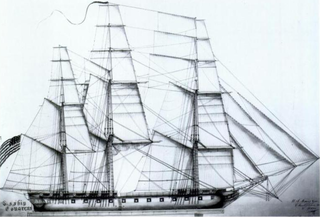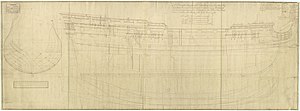
USS Congress was a nominally rated 38-gun wooden-hulled, three-masted heavy frigate of the United States Navy. James Hackett built her at the Portsmouth Naval Shipyard and she was launched on 15 August 1799. She was one of the original six frigates whose construction the Naval Act of 1794 had authorized. The name "Congress" was among ten names submitted to President George Washington by Secretary of War Timothy Pickering in March 1795 for the frigates that were to be constructed.Joshua Humphreys designed these frigates to be the young Navy's capital ships, and so Congress and her sisters were larger and more heavily armed and built than the standard frigates of the period.

USS President was a wooden-hulled, three-masted heavy frigate of the United States Navy, nominally rated at 44 guns; she was launched in April 1800 from a shipyard in New York City. President was one of the original six frigates whose construction the Naval Act of 1794 had authorized, and she was the last to be completed. The name "President" was among ten names submitted to President George Washington by Secretary of War Timothy Pickering in March of 1795 for the frigates that were to be constructed. Joshua Humphreys designed these frigates to be the young Navy's capital ships, and so President and her sisters were larger and more heavily armed and built than standard frigates of the period. Forman Cheeseman, and later Christian Bergh, were in charge of her construction. Her first duties with the newly formed United States Navy were to provide protection for American merchant shipping during the Quasi War with France and to engage in a punitive expedition against the Barbary pirates in the First Barbary War.

The first USS Argus, originally named USS Merrimack, was a brig in the United States Navy commissioned in 1803. She enforced the Embargo Act of 1807 and fought in the First Barbary War – taking part in the blockade of Tripoli and the capture of Derna – and the War of 1812. During the latter conflict, she had been audaciously raiding British merchant shipping in British home waters for a month, when the heavier British Cruizer-class brig-sloopHMS Pelican intercepted her. After a sharp fight during which Argus's captain, Master Commandant William Henry Allen, was mortally wounded, Argus surrendered when the crew of Pelican were about to board.

USS Syren was a brig of the United States Navy built at Philadelphia in 1803. She served during the First Barbary War and the War of 1812 until the Royal Navy captured her in 1814. The British never commissioned her but apparently used her for a year or so as a lazaretto, or a prison vessel. She then disappears from records.
HMS Antelope was a 50-gun fourth rate ship of the line of the Royal Navy, launched at Rotherhithe on 13 March 1703. She was rebuilt once during her career, and served in the Seven Years' War and the American Revolutionary War.

HMS Leander was a 50-gun spar-decked frigate of the Royal Navy which saw service in the Napoleonic Wars, the War of 1812, and the Second Barbary War.

Nautilus was a schooner launched in 1799. The United States Navy purchased her in May 1803 and commissioned her USS Nautilus; she thus became the first ship to bear that name. She served in the First Barbary War. She was altered to a brigantine. The British captured Nautilus early in the War of 1812 and renamed her HMS Emulous. After her service with the Royal Navy, the Admiralty sold her in 1817.

Sir Thomas Slade was an English naval architect best known for designing the Royal Navy warship HMS Victory, which served as Lord Nelson's flagship at the Battle of Trafalgar in 1805.

HMS York was a 74-gun third-rate ship of the line of the Royal Navy, built at Rotherhithe by the contract firm Samuel & Daniel Brent, and launched on 7 July 1807. She saw service during the Napoleonic Wars, though is best known for her time spent as a prison ship. She was broken up in March 1854.

HMS Northumberland was a 74-gun third-rate ship of the line of the Royal Navy, built at the yards of Barnard, Deptford and launched on 2 February 1798. She carried Napoleon to his final exile on St Helena.

Vice-Admiral Sir Joshua Rowley, 1st Baronet was a Royal Navy officer who was the fourth son of Admiral Sir William Rowley. Sir Joshua was from an ancient English family, originating in Staffordshire (England) and was born on 1 May 1734. Rowley served with distinction in a number of battles throughout his career and was highly praised by his contemporaries. Unfortunately whilst his career was often active he did not have the opportunity to command any significant engagements and always followed rather than led. His achievements have therefore been eclipsed by his contemporaries such as Keppel, Hawke, Howe and Rodney. Rowley however remains one of the stalwart commanders of the wooden walls that kept Britain safe for so long.

HMS Caesar, also Cæsar, was an 80-gun third rate ship of the line of the Royal Navy, launched on 16 November 1793 at Plymouth. She was designed by Sir Edward Hunt, and was the only ship built to her draught. She was also one of only two British-built 80-gun ships of the period, the other being HMS Foudroyant.

HMS Plantagenet was a 74-gun third rate ship of the line of the Royal Navy, launched on 22 October 1801 at Woolwich. She was designed by Sir William Rule as one of the 'large class' 74s, and was the only ship built to her draught. As a large 74, she carried 24-pounder guns on her upper gun deck instead of the 18-pounder guns found on the middling and common class 74s.

Bienfaisant was a 64-gun ship of the line of the French Navy, launched in 1754.

HMS Expedition was a 70-gun third-rate ship of the line built at Portsmouth Dockyard in 1677/79. She was in active commission during the War of the English Succession participating in the battles of Beachy Head and Barfleur. She was rebuilt in 1699. Again, for the War of Spanish Succession she was in commission for the operation at Cadiz then returned to England where she sat for two years. She was in the Mediterranean for the Battle of Marbella in 1705. She then went to the West Indies and fought in Wager's action off Cartagena in 1708. She was rebuilt in 1709-14 to the 1706 Establishment. She spent her time split between the Baltic and as guard ship at Portsmouth before being broken at Portsmouth in 1736. She was rebuilt in 1736/40 at Deptford Dockyard.

HMS Argo was a 44-gun fifth-rate Roebuck-class ship of the Royal Navy. She was launched in 1781 from Howdon Dock. The French captured her in 1783, but 36 hours later the British recaptured her. She then distinguished herself in the French Revolutionary Wars by capturing several prizes, though she did not participate in any major actions. She also served in the Napoleonic Wars. She was sold in 1816.

HMS Princess was a 70-gun third rate ship of the line of the Royal Navy. She had served for ten years as the Princesa for the Spanish Navy, until her capture off Cape Finisterre in 1740 during the War of the Austrian Succession.
Vice-Admiral Sir Charles Hardy, also known as Charles Hardy the Elder, was a Royal Navy officer of the eighteenth century. Hardy entered the Royal Navy in 1695, joining his cousin Captain Thomas Hardy's ship HMS Pendennis. Promoted to lieutenant in 1701, he served in several ships of the line before being promoted to commander in 1705. Hardy commanded sloops in the English Channel, Mediterranean and North Seas, before taking command of HMS Dunwich in 1709, in which he was promoted to post captain. Hardy subsequently served for a year at Jamaica before commanding two ships during the Great Northern War between 1718 and 1720. Having changed commands several times, in 1727 he fought at the thirteenth siege of Gibraltar in HMS Kent.

















